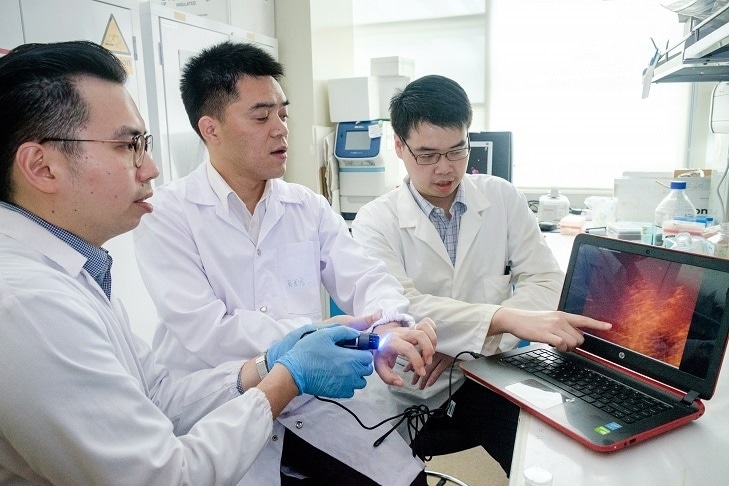Jun 5 2018
A collaborative team of researchers from the Nanyang Technological University, Singapore (NTU Singapore) and the Northwestern University in the United States have developed a new method to see if heavy wound scars are forming and to give doctors a chance to check it.
 Credit: NTU Singapore
Credit: NTU Singapore
Clinicians presently find it hard to predict how scars will form after surgery or after a burn wound, without using invasive testing.
The research team used new nanoparticles in animals and human skin samples to demonstrate the potential to rapidly and accurately predict whether a wound is likely to result in excessive scarring as occurs in skin contractures and keloids.
If required, doctors can then take conventional preventive steps to lessen scar formation, such as using silicon sheets to ensure a wound is flat and moist.
In developed countries alone, around 100 million patients will develop scars each year, arising from 80 million elective and trauma surgery operations. In Singapore, an estimated 400,000 people (1 in 12 people going through procedures) develop scars each year because of surgery.
Excessive scarring can greatly affect a patient’s quality of life, both psychologically and physically, as the scars can inhibit activity and movement, and can be painful when strained.
The new method was formulated by a team led by Assistant Professor Xu Chenjie from NTU’s School of Chemical and Biomedical Engineering, nanoscience expert Professor Chad A Mirkin from Northwestern University, United States, and Dr Amy S Paller, Chair of Dermatology at Northwestern University Feinberg School of Medicine.
How it works
The new detection technique, reported last month in the Nature Biomedical Engineering journal, uses numerous nanoparticles known as NanoFlares, which have DNA strands fixed to their surfaces like a ball of spikes.
These nanoparticles can be applied to closed wounds using a cream. Once the nanoparticles have entered the skin cells for 24 hours, a handheld fluorescence microscope is used to detect signals emitted by the nanoparticles’ interaction with target biomarkers within the skin cells.
If fluorescence signals are detected, they specify abnormal scarring activity and preventive steps can be taken to hopefully avoid deep scarring.
Pain-free detection method
Presently, besides the visual examination of mature scars, the only other tool to spot skin diseases accurately is to conduct a biopsy, where a skin tissue sample is extracted and taken to a lab for testing.
These biopsies may be painful and difficult for patients, as an open wound also attracts infections and requires sutures which must be removed later.
Assistant Professor Xu Chenjie said, “When our bioengineered nanoparticles are applied on the skin, they will penetrate up to 2mm below the skin surface and enter scar cells.”
Upon binding with a specific tell-tale gene released by the scar cells, smaller DNA spikes are knocked loose and light up under the microscope like little light flares. The more flares we see, the more scarring activity there is.
Assistant Professor Xu Chenjie
These NanoFlares are made by coating Northwestern’s patented gold nanoparticles with minute DNA strands targeting specific genes. It has shown minor side effects or toxicity when tested on rabbits, mice, and on human skin samples.
Dr Amy S Paller, who is also the Director of Northwestern University Skin Disease Research Centre, said, “Beyond clinical observation, the gold standard for both clinical diagnosis and translational research of skin disorders is a biopsy.”
This technology is an exciting first step towards having a non-invasive way to detect increases or decreases in gene expression. NanoFlares may prove to be a new tool to facilitate sub-phenotyping of disease based on expression patterns and leveraging gene expression changes as a sensitive way to detect early treatment responses.
Dr Amy S Paller, Director, Skin Disease Research Centre, Northwestern University
Dr Hong Liang Tey, Dermatologist and Head of Research at National Skin Centre, Singapore, who is not involved in this study, said, “This technology (NanoFlares) that can provide non-invasive biopsy for different types of skin disease, can potentially be very helpful in clinical practice and its applications should certainly be further explored.”
The NanoFlares were formed after two years of research by the joint team, which included NTU research fellows Dr David Yeo and Dr Christian Wiraja, who performed the laboratory experiments.
Future applications
In other newly published or accepted peer-reviewed journal articles, such as in a SLAS Technology commentary, Dr Yeo further explains on the possible applications of NanoFlares for other skin diseases such as skin cancer, as the DNA sequences on the nanoparticles are interchangeable.
This new technique could be an additional tool to track and examine other skin diseases which conventionally depend heavily on biopsies for detection.
Now that the NanoFlares are established to be able to bind to a target biomarker and offer easy visual detection, in theory, various DNA spikes could be designed to target biomarkers plentiful in other common skin diseases.
The researchers have filed a patent application based on this technology via NTU’s innovation and commercialization arm, NTUitive, and aim to license out the technology for commercialization.